by Amelia M.L. Montes (ameliamontes.com)
 |
| Diabetes: When the pancreas cannot produce healthy shaped cells that can absorb glucose in the bloodstream, glucose remains in the blood vessels, damaging vessels and also damaging organs throughout the body. |
 |
| This is a helpful book (click here) that helps people who wish to curb a high sugar diet. Great tips in here to create your own individualized diet that can work for you. There is also good scientific explanations about food and glucose. |
I’ve thoughtabout what this doctor and others have similarly said. And in reading so much about thisDisease, I’ve also understood another aspect to the patient’s inabilities tochange.
First: It’s very hard to come home after adiagnosis and be told to completely change your diet. To what? Howdoes one know? Insurance companiesoften will not include “Diabetes Education” for patients until they areactually diagnosed with the disease. For those who are diagnosed as “PRE-Diabetic” (meaning that there isevidence of high glucose levels but not quite high enough for the Diabetesdiagnosis), there is no education. This should be the exact time when much of the education should takeplace. Or, if it is apparent thatthe disease is a genetic factor in an individual’s family history, thatindividual should have the opportunity to enroll in Diabetes education even ifshe/he may never manifest the disease—at least they are more equipped to understandand help other family members or friends who have it.

 |
| Dr. Bernstein's _Diabetes Solution_ is another book that can be helpful in understanding what is meant by "normal blood sugars" |
Third: A key component to understanding yourbody is to test your blood and if you are on a very tight budget, this can bedifficult. The glucose test monitoris often available for “free” (once you’re diagnosed). But the problem here concerns the test strips which areexpensive. Just yesterday, Ibought (with my prescription) my supply of test strips. There are 100 in two vials. With insurance: $62. Without insurance: $124.
If you do nothave diabetes (but you know it runs in your family and you’d like to startmonitoring your blood so you will prevent the disease) or if you have been toldyou have “pre-diabetes”—you will have to shell out the $124. Something needsto happen so that the cost of test strips can be more affordable making it possible for people to purchase. I'm not sure what the answer is yet. Why testing isso important: Without testing, youhave no idea what your body is doing. You could feel just fine and your body may be riding on high levels ofglucose and the longer you have such high levels running throughout yourbloodstream, the quicker you will damage various organs in the body. It will only take a few months beforethe damage manifests itself in a variety of ways (neuropathy, retinopathy,nephropathy).
 |
| Mintz's Sweetness and Power is a very accessible, slim paperback that will give you vital information about the history of sugar and why our contemporary diet has such an overabundance of sugar which is one of the main causes for this epidemic. |
The U.S. canboast about all of us being hard-working people who produce more in a year thanneighboring countries around the world. And we do. However, a study showed that even though we produce more, we also makemore mistakes (because we are overworked) and therefore spend millions havingto correct those mistakes. We alsospend millions on emergency hospital visits and doctor’s visits. The first year of my diagnosis, I endedup in the emergency room three times and even with insurance, my out-of-pocketexpenditure to medical issues topped at $6,000.
What to do?
Some tips:
A QUICKRECIPE: I have found “mashedcauliflower” a most delicious substitute for mashed potatoes. Potatoes are not good for all individuals with Diabetes. The high starch contentwill affect most people (and that includes rice as well—brown or white).
Mashedcauliflower is easily frozen so you can make a lot of it, freeze it, and thenyou don’t have to keep taking the time to cook it each time you want some.
 |
| I never pay attention to calories or fat counts anymore. The carbohydrate counts in this little book are what are most important to those of us with Diabetes. Our food industry misguides us to think that calories are what we need to watch. What food companies do is they take the fat (good fat!) out of foods and replace it with more and more carbohydrates. What makes us gain weight is the carbohydrate, not the fat. But we've all been programmed to think it's all about fat. |
4. For exercise: If you cannot afford a gym or cannot exercise outside, walkaround your house (inside), or climb stairs (if stairs are at your work, taketime to walk up and down during half your lunch hour) if there are stairs at ornear home or at work. Purchase a new/usedbike if you can afford it.
Discoveries:
The mostimportant aspect I have discovered in researching this disease is understandinghow each individual (chemically) is so vastly different. Two people with Diabetes may react verydifferently when they eat, say, a banana. I know someone with Type II Diabetes who enjoys eating a banana everyday and their glucose levels do not spike. I cannot eat a banana—not even a bite because then myglucose levels spike. The onething to understand about Diabetes is that the journey to balance glucoselevels demands a journey into keenly understanding your body. Our bodies are like fingerprints. Our chemical and genetic makeup is sofascinatingly individual. And ittakes commitment to want to do this. But it can be done!
 |
| If you are very interested in history-- History of the Pancreas is a fascinating account of the pancreas! I suggest getting it from your local library because it's too expensive to buy. |
I am wishing allof you a healthy Octubre! And I invite you to e-mail me if you have questions! Abrazos a ti, Querida/Querido Bloga reader!
Hiç yorum yok:
Yorum Gönder